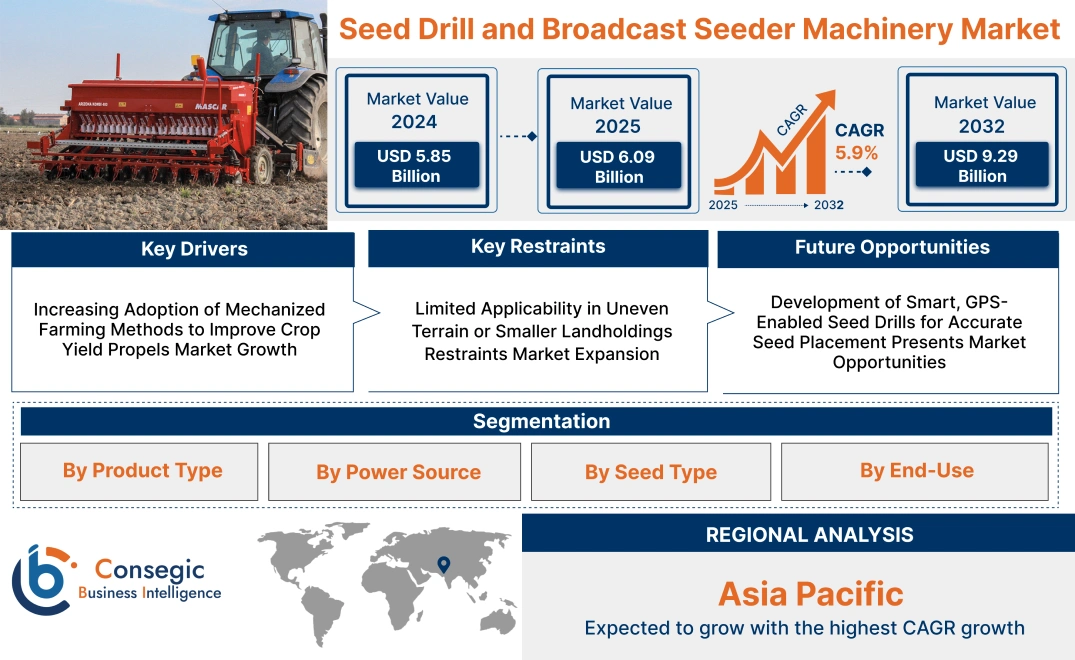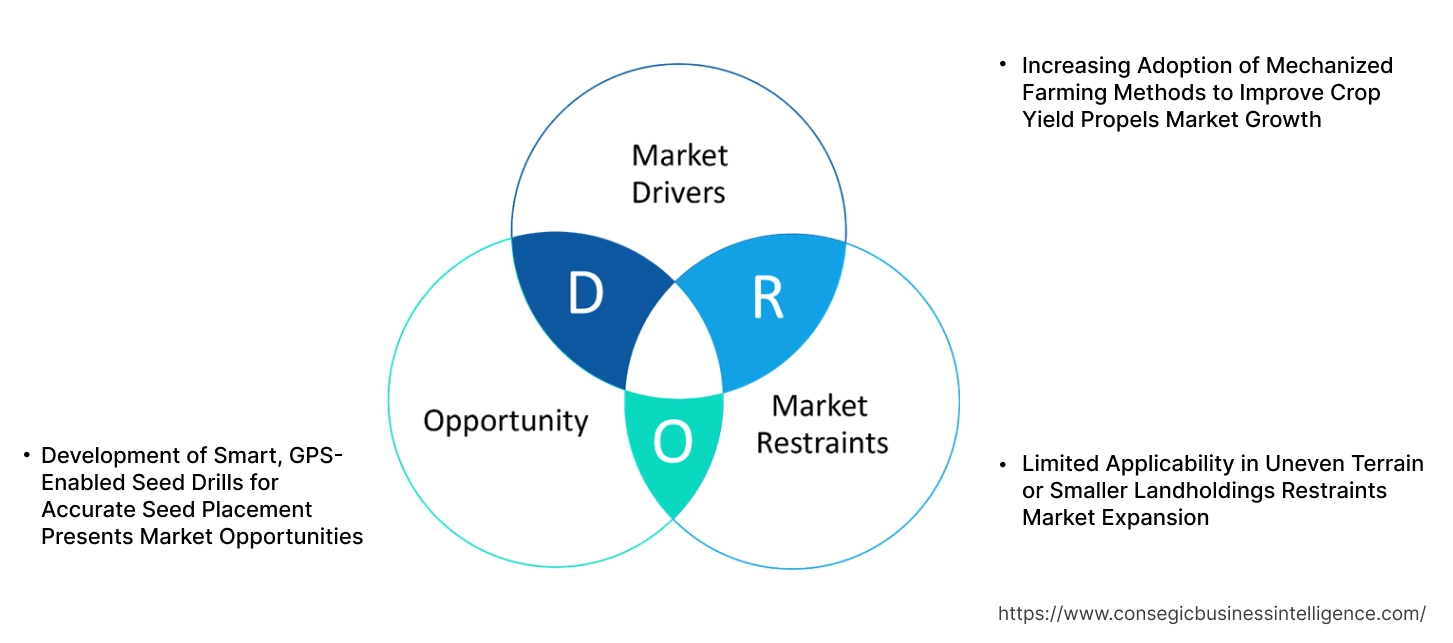Seed Drill and Broadcast Seeder Machinery Market Size:
Seed Drill and Broadcast Seeder Machinery Market size is estimated to reach over USD 9.29 Billion by 2032 from a value of USD 5.85 Billion in 2024 and is projected to grow by USD 6.09 Billion in 2025, growing at a CAGR of 5.9% from 2025 to 2032.
Seed Drill and Broadcast Seeder Machinery Market Scope & Overview:
Seed drill and broadcast seeder machinery includes precision equipment designed to disperse seeds uniformly across agricultural fields, enhancing planting efficiency and crop establishment. These systems are widely used in row crop farming, pasture development, and cover cropping applications.
Seed drills place seeds at controlled depths and spacing using furrow openers and metering mechanisms, while broadcast seeders distribute seeds over the surface using rotating disks or airflow systems. Both machines are available in tractor-mounted, trailed, or self-propelled formats to accommodate diverse field conditions and farm sizes.
Key features include adjustable seed rates, compatibility with various seed types, and integration with GPS-guided controls. The use of seed drill and broadcast seeder machinery ensures uniform germination, reduces seed waste, and promotes consistent crop stands. Their adaptability and accuracy support time-saving, resource-efficient planting, making them essential components in modern mechanized farming systems.
How is AI Transforming the Seed Drill and Broadcast Seeder Machinery Market?
AI is transforming the seed drill and broadcast seeder market by enabling precision agriculture through real-time data analysis, variable-rate seeding, and autonomous operations, leading to optimized seed placement, reduced waste, and improved crop yields. Moreover, AI algorithms analyze soil conditions, weather data, and plant health in real-time, allowing machines to adjust seed density and placement for optimal coverage. Additionally, the key applications include AI-powered sensors and GPS for precise navigation and adaptive seeding, machine learning for predictive maintenance and customized sowing patterns, and integration with drones and other smart farming systems for constant monitoring and decision support. Hence, these advancements enhance efficiency, reduce labor dependency, and create more resilient and productive farming operations.
Seed Drill and Broadcast Seeder Machinery Market Dynamics - (DRO) :
Key Drivers:
Increasing Adoption of Mechanized Farming Methods to Improve Crop Yield Propels Market Growth
The growing demand for higher crop yields, coupled with the need for more efficient farming practices, is driving the widespread adoption of mechanized farming equipment. Seed drills and broadcast seeders are key components in modern agriculture, allowing farmers to plant seeds more uniformly and at optimal depths, ensuring better germination and growth. Mechanization not only increases planting speed but also reduces labor costs, making it highly attractive for large-scale commercial farms. As the pressure to feed a growing global population intensifies, farmers are increasingly turning to technology-driven solutions to improve productivity. The ability to plant various seed types efficiently in different soil conditions has significantly increased the need for these machines.
- For instance, in August 2024, Kubota unveiled a new generation of cultivator-mounted seed drill, the SD1001M. Since individual farming systems differ, this model offers farmers flexibility and precision. The updated coulter bar design enables optimum soil penetration, less soil disturbance and more precise seed placement at an even sowing depth. Furthermore, its compact structure reduces the lifting power required.
As agriculture continues to embrace precision farming techniques, the machinery will see continued requirement, driving the seed drill and broadcast seeder machinery market expansion.
Key Restraints:
Limited Applicability in Uneven Terrain or Smaller Landholdings Restraints Market Expansion
While seed drills and broadcast seeders offer enhanced efficiency for large-scale farming, their applicability is limited in uneven terrains or smaller landholdings. On uneven or hilly landscapes, the equipment may struggle to provide consistent seed depth and uniformity due to its design, which is optimized for flat, expansive fields. Additionally, smaller landholders or those operating in confined spaces may find large machinery impractical or difficult to maneuver. For small-scale farmers, high initial costs and the lack of necessary infrastructure to support such equipment further limit adoption. These limitations in both functionality and access are creating obstacles to broader market penetration, restricting the potential seed drill and broadcast seeder machinery market growth, especially in developing regions where smallholdings dominate.
Future Opportunities :
Development of Smart, GPS-Enabled Seed Drills for Accurate Seed Placement Presents Market Opportunities
Advancements in technology are revolutionizing seed planting methods, with GPS-enabled seed drills offering precise seed placement, reduced overlap, and minimized seed wastage. These systems allow farmers to monitor and control seed depth, spacing, and planting patterns with greater accuracy, leading to improved crop yields and efficient use of resources. The demand for smarter, data-driven farming solutions is increasing, as precision farming tools help optimize land use, reduce input costs, and enhance productivity. The integration of IoT, machine learning, and real-time data analytics into seed drills is opening up new avenues for market expansion, especially in developed agricultural markets.
- For instance, Amazone H. Dreyer GmbH & Co. KG offers GPS-Switch, a device compatible with all ISOBUS-enabled fertilizer spreaders, crop protection sprayers and seed drills. It provides GPS-based, fully automatic, part-width section control for precise sowing of seeds. This reduces operator stress, saves input costs and ensures lesser crop damage.
As digital agriculture continues to grow, these smart systems provide clear advantages for large-scale and high-tech farms, driving seed drill and broadcast seeder machinery market opportunities with a focus on precision and sustainability.
Seed Drill and Broadcast Seeder Machinery Market Segmental Analysis :
By Product Type:
Based on product type, the market is segmented into seed drills, broadcast seeders, precision seeders, multi-crop seeders, and others.
The seed drills segment accounted for the largest revenue share of 40.3% in 2024.
- Seed drills are widely used for planting seeds with precision, ensuring uniform depth and spacing for optimal crop growth.
- This equipment is particularly popular in large-scale agricultural operations where efficiency and precision are crucial for maximizing yields.
- The need for seed drills is driven by the increasing need for automated planting solutions and the growing focus on precision agriculture.
- As per seed drill and broadcast seeder machinery market analysis, the seed drill segment continues to lead due to its critical role in modern farming, providing high planting accuracy and consistent crop emergence.
The precision seeders segment is expected to experience the fastest CAGR during the forecast period.
- Precision seeders allow for the accurate placement of seeds, which is essential for crops that require exact spacing and depth for optimal growth.
- These seeders are ideal for high-value crops such as vegetables and flowers, where planting density and precision are critical for yield quality.
- The rise of precision agriculture, which incorporates advanced technologies like GPS and sensors, is driving need for precision seeders.
- According to segmental trends, the precision seeders segment is driving rapid seed drill and broadcast seeder machinery market growth as farmers and agricultural companies look for more efficient ways to optimize planting practices and reduce input costs.
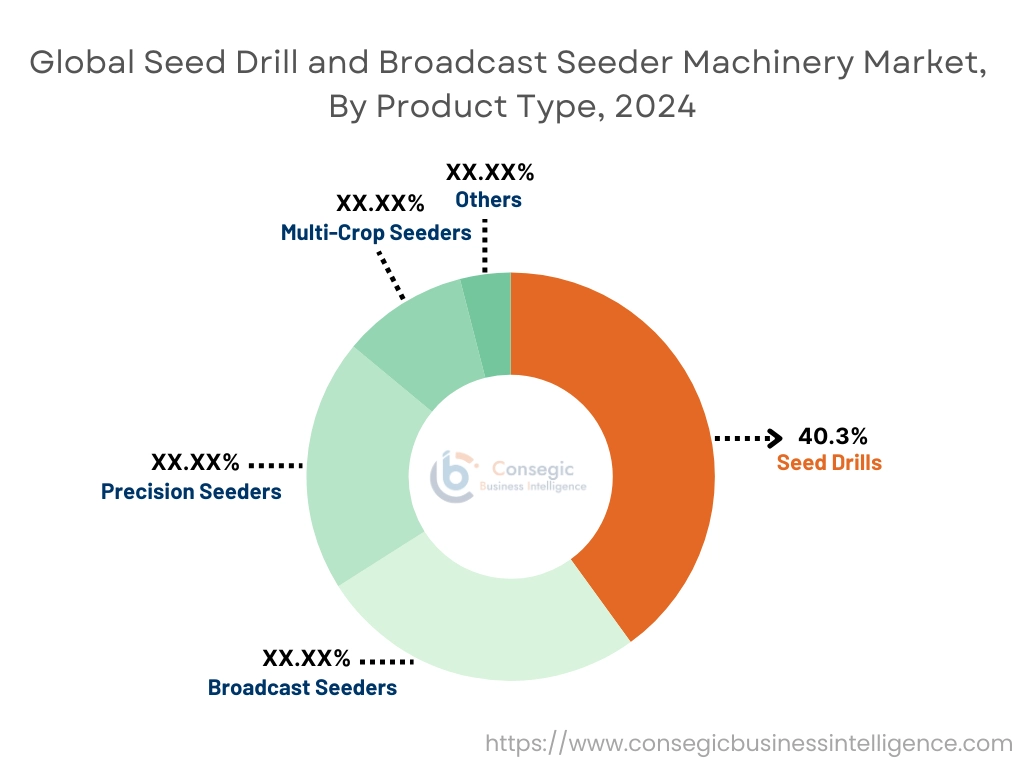
By Power Source:
Based on power source, the market is segmented into diesel, electric, manual, and hybrid.
The diesel segment held the largest seed drill and broadcast seeder machinery market share in 2024.
- Diesel-powered seed drill and broadcast seeder machinery are widely used in large-scale farming operations due to their robust performance and ability to handle heavy workloads.
- These machines offer higher efficiency and longer operational hours, making them ideal for commercial agriculture.
- Diesel-powered machinery is particularly useful in regions where electrical infrastructure is limited or where energy independence is a priority.
- As per seed drill and broadcast seeder machinery market demand, diesel remains the most popular power source due to its efficiency and performance in large-scale applications.
The electric segment is projected to witness the fastest CAGR during the forecast period.
- Electric-powered seeders are gaining popularity due to their lower environmental impact and quieter operation compared to diesel-powered machines.
- They are particularly suitable for small- to medium-sized farms, urban agriculture, and areas with strict emissions regulations.
- Electric seeders provide a cost-effective and sustainable solution, making them highly attractive to eco-conscious farmers.
- According to seed drill and broadcast seeder machinery market trends, the shift towards electric-powered equipment is accelerating as agricultural sectors move towards greener, more sustainable practices.
By Seed Type:
Based on seed type, the market is segmented into cereals, pulses, oilseeds, vegetables, and others.
The cereals segment accounted for the largest seed drill and broadcast seeder machinery market share in 2024.
- Seed drill and broadcast seeder machinery are widely used for planting cereals such as wheat, rice, corn, and barley, which make up a significant portion of global crop production.
- The demand for machinery in the cereal segment is driven by the need for large-scale, efficient planting in both developed and emerging economies.
- Cereal crops are primarily grown in vast fields, requiring high-efficiency machines that can plant seeds quickly and evenly.
- As per seed drill and broadcast seeder machinery market analysis, the cereals segment remains dominant due to the high production volume of these staple crops and the widespread use of seeding equipment for their planting.
The vegetable segment is expected to grow at the fastest CAGR during the forecast period.
- Vegetables require precise planting for optimal yield, which has led to increased adoption of precision seeders in vegetable farming.
- The requirement for vegetables is rising globally, and with this growth comes the need for more efficient farming equipment that can handle delicate crops like tomatoes, lettuce, and carrots.
- Precision seeders designed for vegetable farming help improve planting efficiency and reduce seed waste, driving adoption in the sector.
- According to segmental trends, the vegetable segment is expected to propel rapid seed drill and broadcast seeder machinery market expansion as more farmers move toward high-efficiency farming practices.
By End-Use:
Based on end-use, the seed drill and broadcast seeder machinery market is segmented into agriculture, forestry, government, research institutes, horticulture, and others.
The agriculture segment held the largest revenue share in 2024.
- Seed drill and broadcast seeder machinery are essential in large-scale farming operations where high-efficiency planting is needed for both cereal and specialty crops.
- The agricultural sector’s expansion, driven by population growth and the need for sustainable food production, continues to drive the need for advanced seeding machinery.
- Increasing investments in mechanization and automation in agriculture are fueling the adoption of these systems, especially in emerging markets.
- As per seed drill and broadcast seeder machinery market trends, agriculture remains the primary end-use industry, contributing significantly to market revenue.
The horticulture segment is expected to experience the fastest CAGR during the forecast period.
- Horticulture, which involves the cultivation of fruits, vegetables, flowers, and ornamental plants, requires precise and efficient planting techniques.
- The rise in home gardening, urban farming, and the increasing need for organic produce are driving the demand for advanced seeding technologies in horticulture.
- The need for machines that can handle a variety of seed types and planting densities is increasing the adoption of specialized seeders in this industry.
- According to market trends, the horticulture segment is expanding seed drill and broadcast seeder machinery market demand due to the rising interest in sustainable, high-yield farming practices.
Regional Analysis:
The regions covered are North America, Europe, Asia Pacific, the Middle East and Africa, and Latin America.
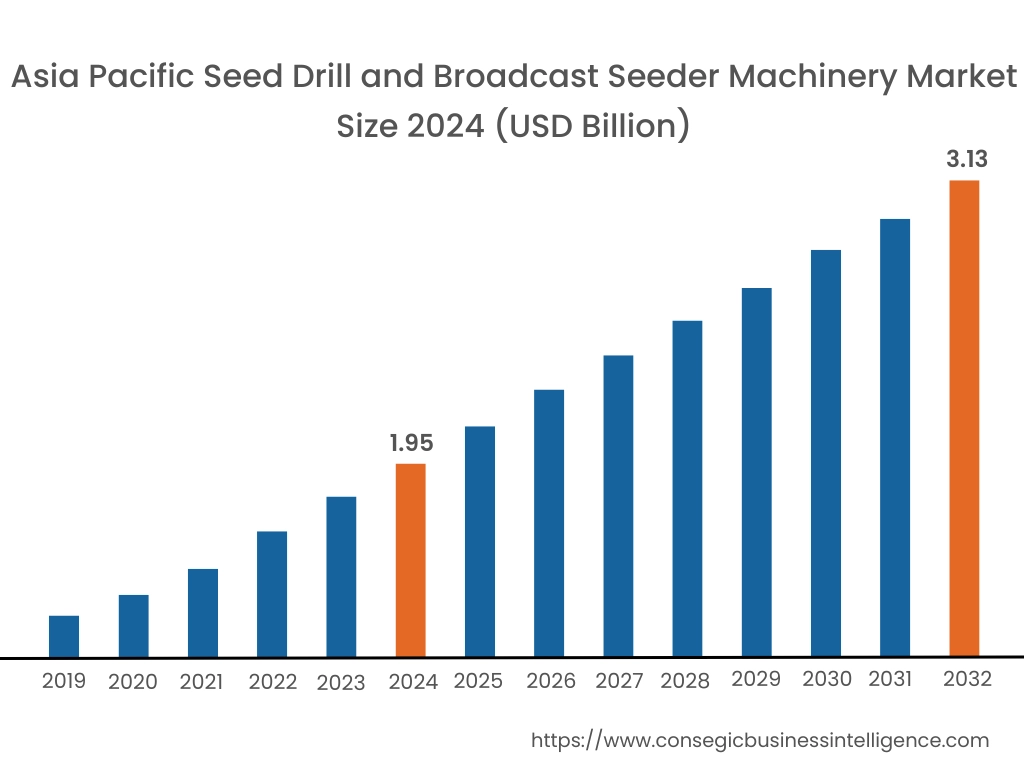
Asia Pacific region was valued at USD 1.95 Billion in 2024. Moreover, it is projected to grow by USD 2.03 Billion in 2025 and reach over USD 3.13 Billion by 2032. Out of this, China accounted for the maximum revenue share of 48.4%. Asia-Pacific is experiencing rapid rise in the seed drill and broadcast seeder machinery industry due to increasing agricultural mechanization and the push for higher food productivity. China, India, Australia, and Japan are key markets where farmers are transitioning from manual sowing methods to mechanical seeding. Market analysis indicates rising need for compact, multi-crop compatible seeders that are adaptable to varied soil types and cropping patterns. In regions like Southeast Asia, smallholder farmers are adopting entry-level machinery, while commercial farms seek precision drills for wheat, rice, and pulses. Regional growth is fueled by government initiatives to modernize agriculture and increase rural mechanization rates.
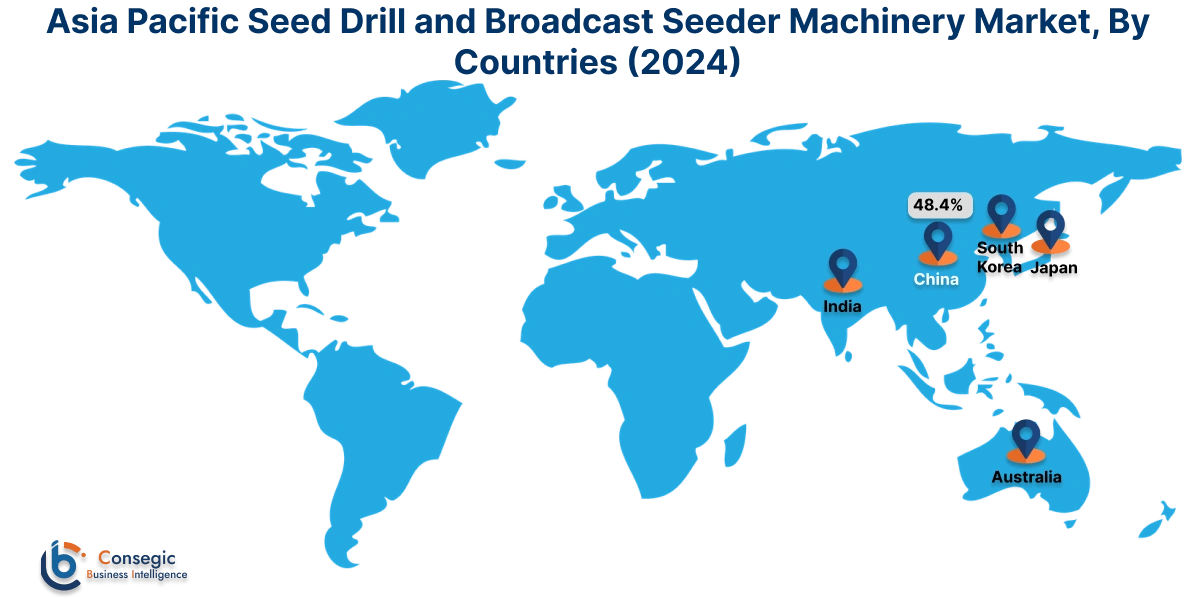
North America is estimated to reach over USD 2.73 Billion by 2032 from a value of USD 1.72 Billion in 2024 and is projected to grow by USD 1.79 Billion in 2025. North America stands as a mature market, particularly in the United States and Canada where large-scale farming operations emphasize precision agriculture practices. Market analysis indicates strong necessity for seed drills equipped with GPS-guided systems and variable rate technology to optimize seeding density and minimize input wastage. Development in this region is supported by government incentives for precision farming, aging equipment replacement cycles, and the expansion of no-till and conservation agriculture methods. Additionally, rental and leasing options are helping smaller farmers access advanced machinery, further broadening market penetration.
Europe presents a technologically sophisticated market where seed drill and broadcast seeder machinery is widely adopted across diverse crop systems, especially in Germany, France, and the United Kingdom. Market analysis reveals that environmental sustainability goals are influencing equipment choice, favoring low-disturbance drills that enhance soil health. Increasing regulatory focus on soil conservation and emission reductions is driving innovation in lightweight, energy-efficient machinery. The market opportunity in Europe is closely tied to organic farming expansion, subsidy programs supporting precision agriculture, and the adoption of intelligent seeding control systems across mid- and large-sized farms.
Latin America is steadily adopting seed drill and broadcast seeder machinery, particularly in Brazil, Argentina, and Mexico where agribusiness expansion drives the need for improved sowing practices. Market analysis highlights a preference for high-capacity drills that can operate efficiently over large tracts of soybean, maize, and wheat fields. Conservation agriculture practices are gaining traction, leading to increased use of no-till seeders that maintain soil integrity. The seed drill and broadcast seeder machinery market opportunity in this region is enhanced by rising exports of agricultural produce, growing investment in farm mechanization, and increased awareness of yield optimization technologies.
In the Middle East and Africa, adoption of seed drill and broadcast seeder machinery is emerging, primarily in South Africa, Egypt, and parts of the Gulf region. Market research reveals growing demand for durable, low-maintenance machinery capable of operating under arid and semi-arid conditions. Governments are supporting agricultural modernization through equipment subsidies and irrigation expansion programs, fostering opportunities for seeder machinery deployment. While mechanization levels remain varied, growth potential exists through targeted training programs, expansion of irrigation infrastructure, and efforts to boost food self-sufficiency through improved crop production techniques.
Top Key Players and Market Share Insights:
The seed drill and broadcast seeder machinery market is highly competitive with major players providing products and services to the national and international markets. Key players are adopting several strategies in research and development (R&D), product innovation, and end-user launches to hold a strong position in the global seed drill and broadcast seeder machinery market. Key players in the seed drill and broadcast seeder machinery industry include -
- KUHN Group (France)
- Amazone H. Dreyer GmbH & Co. KG (Germany)
- Bertini S.A. (Argentina)
- Agromaster Agricultural Machinery (Turkey)
- Balwan Agro Industries (India)
- Kverneland Group (Norway)
- Maschio Gaspardo S.p.A. (Italy)
- SULKY-BUREL (France)
- Väderstad AB (Sweden)
- Lemken GmbH & Co. KG (Germany)
Recent Industry Developments :
Acquisitions:
- In January 2023, LEMKEN acquired Equalizer, the South African seeding technology specialist, to expand its product portfolio. The Equalizer product range includes seed drills with a working width of up to 24 metres.
- In November 2022, PÖTTINGER completed the acquisition of MaterMacc Spa, the Italian manufacturer of precision seeding solutions. This decision complements the product portfolio of PÖTTINGER and enables continued innovation for advanced agriculture solutions.
Partnerships:
- In April 2025, Seed Processing Holland B.V. renewed its collaboration with SpecAgri Technologies, the India-based strategic service partner. This enables the provision of excellent local support and service to the Indian customers.
Seed Drill and Broadcast Seeder Machinery Market Report Insights:
| Report Attributes | Report Details |
| Study Timeline | 2019-2032 |
| Market Size in 2032 | USD 9.29 Billion |
| CAGR (2025-2032) | 5.9% |
| By Product Type |
|
| By Power Source |
|
| By Seed Type |
|
| By End-Use |
|
| By Region |
|
| Key Players |
|
| North America | U.S. Canada Mexico |
| Europe | U.K. Germany France Spain Italy Russia Benelux Rest of Europe |
| APAC | China South Korea Japan India Australia ASEAN Rest of Asia-Pacific |
| Middle East and Africa | GCC Turkey South Africa Rest of MEA |
| LATAM | Brazil Argentina Chile Rest of LATAM |
| Report Coverage |
|
Key Questions Answered in the Report
How big is the Seed Drill and Broadcast Seeder Machinery Market? +
Seed Drill and Broadcast Seeder Machinery Market size is estimated to reach over USD 9.29 Billion by 2032 from a value of USD 5.85 Billion in 2024 and is projected to grow by USD 6.09 Billion in 2025, growing at a CAGR of 5.9% from 2025 to 2032.
What specific segmentation details are covered in the Seed Drill and Broadcast Seeder Machinery Market report? +
The Seed Drill and Broadcast Seeder Machinery market report includes specific segmentation details for product type, power source, seed type and end-use.
What are the end-use of the Seed Drill and Broadcast Seeder Machinery Market? +
The end-use of the Seed Drill and Broadcast Seeder Machinery Market are agriculture, forestry, government, research institutes, horticulture, and others.
Who are the major players in the Seed Drill and Broadcast Seeder Machinery Market? +
The key participants in the Seed Drill and Broadcast Seeder Machinery market are KUHN Group (France), Amazone H. Dreyer GmbH & Co. KG (Germany), Kverneland Group (Norway), Maschio Gaspardo S.p.A. (Italy), SULKY-BUREL (France), Väderstad AB (Sweden), Lemken GmbH & Co. KG (Germany), Bertini S.A. (Argentina), Agromaster Agricultural Machinery (Turkey) and Balwan Agro Industries (India).
